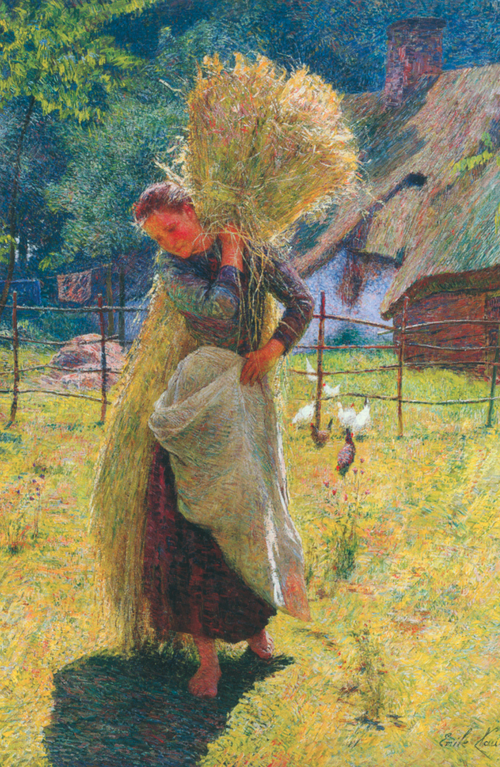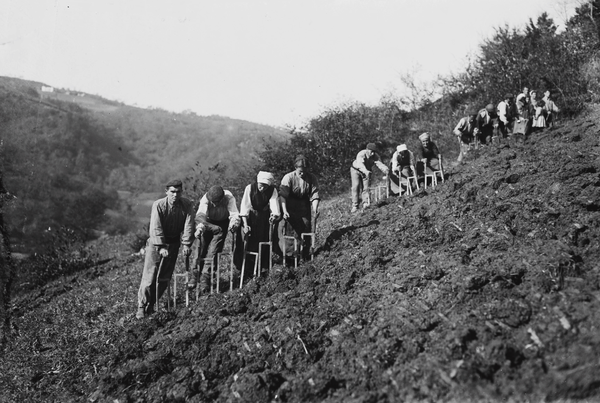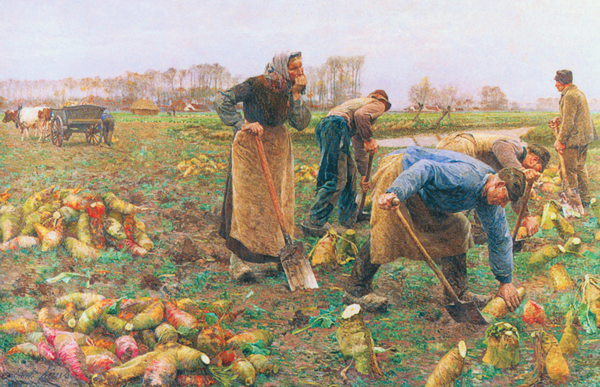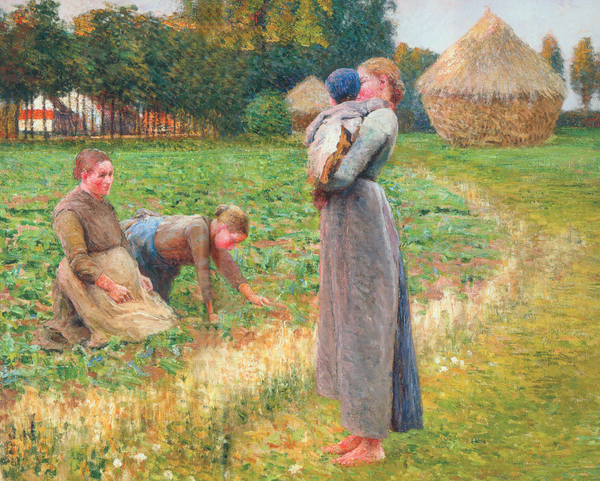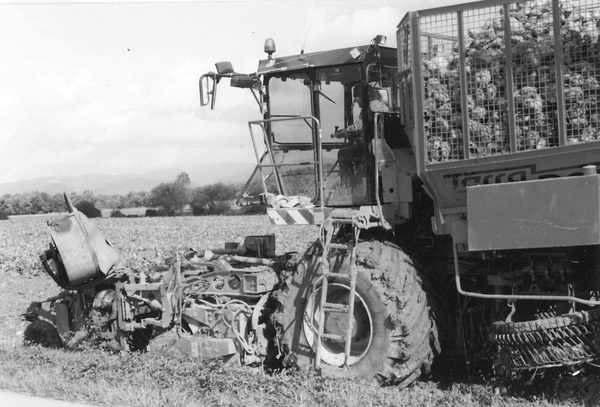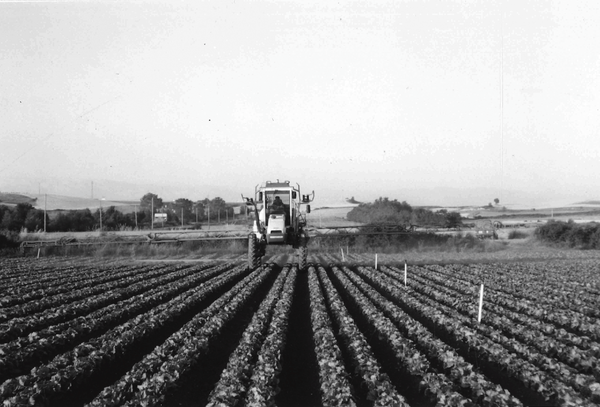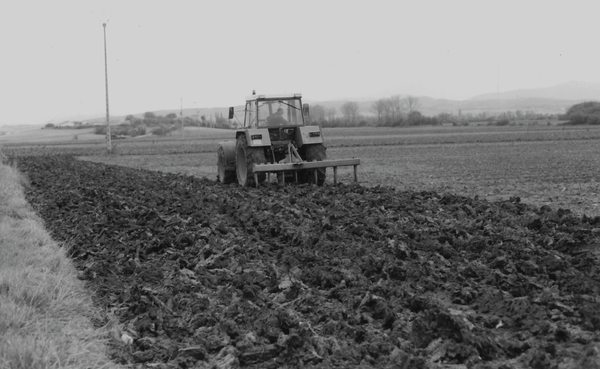General remarks on agriculture
Page content
Contents of the book
This volume on Basque traditional agriculture addresses many of the aspects related to this activity, beyond cultivating the land per se.
It starts with an overview of the different agricultural landscapes that make up the Basque Country, with each area – the Mediterranean and Atlantic sides of the watershed – having its own characteristic crops.
It also contains information on the different types of arable land and their characteristics, sizes of the plots and their situation and separation.
As regards growing crops per se, different aspects are addressed, such as the growing seasons, the influence attributed to the moon, the crop distribution on the different types of holdings, the crop rotation, the farming calendar and the selection, storage and preparation of the seeds and of the seedbeds. It also describes the initial ploughing of the land and the preparing of the plots that had already been cultivated, along with the traditional use of organic compost, lime soil improvers and the introduction of chemical fertilizers.
Another chapter reflects the diversity of crops observed in the territory studied and the sowing or planting of the different plant species, basically grouped into cereals, legumes and vegetables. A difference is made between the crops used to feed humans and those used as animal feed. This takes into account that nothing was wasted in the traditional way of life, as the surplus food for human consumption and any leftovers were used in turn to feed livestock. The so-called industrial crops are also brought into the spotlight, where sugar beet is the best example. The care applied to ensure that they all grow successfully is covered as well. A subsequent chapter considers the harvesting of the crops and the traditional storage methods. The work to reap the cereals and the subsequent threshing and winnowing of the grain stand out here.
There is a chapter on grass, which is more typical of the Atlantic side of the watershed and the transition zone to the Mediterranean-facing area, on the creation and upkeep of the meadows and the use of grass by means of grazing, silage and haymaking. The changes that occurred due to the progressive introduction of machinery are also recorded.
As regards fruit trees, an initial chapter highlights the differences in their cultivation, conditioned by the different climates of the territory, how the planting takes places, the grafting of new varieties, caring for the trees, with special emphasis on the pruning and the harvesting and use of the fruit obtained. A chapter is dedicated to olives and vines given their importance in the southern area of the Basque Country. This series of chapters on fruit trees ends with another on the production of oil and wine on the Mediterranean-facing side and of txakoli white wine and cider on the Atlantic-facing side.
The last of the chapters dedicated expressly to crops is the one that studies two grown in the past: flax and hemp, closely linked to the self-sufficiency of the farmsteads.
The following set of chapters begins with an extensive review of the traditional agriculture chattel needed to perform that activity. The traits of self-sufficiency are again seen as most of them were mainly produced locally or at home. Mention is also made of the old measurement system, part of which is still used today.
The workforce is also analysed, along with the importance of all the members of the family being involved in the agricultural work, regardless of their age or sex and neighbours working together. As regards the Mediterranean-facing side, the contracting of day workers is covered, particularly at harvest time, given the area involved and the speed at which the crops had to be gathered. The importance of animal power is also described, particularly at a time when the machinery as we know it today had still not appeared.
There is a chapter on animal transport, particularly the ox cart given the key role it played, along with the yoke and all the accessories needed to harness the pair of cattle. The last chapter in this block addresses the mechanisation of agriculture and the changes that modern machinery have meant to farming.
Another chapter covers the use of production for the holdings’ own needs and agricultural trade: buying seeds and plants, fertilizer and implements, holding markets and agricultural fairs, etc.
There is another chapter on the form of ownership of the land: owners who directly exploit their land or do so by means of tenants, rent prices, payment schedules and if the payments were in kind or in cash.
The volume ends with the beliefs and rites linked to farming in the past, such as protecting the seedbeds, blessing the seeds and fields, spells against storms, rituals involving the saints and the patron saints of the harvests.
This volume goes hand in hand with a previous one on livestock and shepherding, given the intricate relationship between all those activities at the rural homestead in the past, prior to the gradual specialisation that occurred in the second half of the 20th century. That specialisation would lead to part of the territory studied, the Mediterranean side of the watershed, opting for a more clearly arable farming activity, while livestock would end up predominating on the Atlantic-facing side.
Farming takes us back to remote periods of our past and recalls what was already said regarding shepherding.
Two thousand years ago, Pliny the Elder established a division between the Vasconum saltus and the Vasconum ager, the former damp and wooded, and the second sown with cereals and vineyards, which tally with the damp and dry zones of the Basque Country, respectively. The volume on livestock farming and shepherding mainly focused on the land on the damper side of the watershed, while this one is on the drier and arable farming area. However, it should always be remembered that both livestock and arable farming were to be found throughout the rural Basque Country in the traditional society and, to a great extent, in the primary sector that still survives today.
Traditional agriculture
The agriculture described in this volume of the Basque Ethnographic Atlas is an overview of what mainly was to be found in the 20th century. However, as can be seen in the different chapters making up this work, clear preference is given to the farming practices prior to the intense mechanisation from the 1960s onwards. That does not alter the fact that information has been gathered on the modern farming mainly to be found on the Mediterranean-facing side of the territory, which is clearly more arable and where that activity has undergone a similar transformation to the one experienced in other arable farming regions not only of Spain but also of the European Union.
Given the age of the informants and that part of the information was gathered decades ago, we have focused on farming from the end of the 19th to the mid-20th century.
That farming was family-run, involved all members of the homestead regardless of their age or sex and focused on self-sufficiency or at least as far as it could.
It required in-depth knowledge of the natural environment in which it was carried out: of the relief and the soil characteristics of the land, of the climate, the seasons and, in short, of the seasonal cycles, of water availability, as well as of all aspects of each crop, from preparing the land and sowing the crop to harvesting and its storage in ideal conditions.
That knowledge was not a rigid, but rather a permeable body of expertise, as the person who cultivated the land was always open to trying new seeds and even techniques, but from empiricism that meant checking that it worked. Despite the disdain shown by modern society, that knowledge was scientific to a certain extent as it was based on the technique of trial and error. Furthermore, it was accumulative as the knowledge gained by each generation was added to the received expertise and passed on to the following one. Thanks to this accumulated knowledge, each family also knew which part of its land was best for each type of crop.
This know-how came from the deep-rooted link that was established with the land. In the case of an economy based on self-sufficiency, there was no other option than to respect the land, as their very livelihood depended on it. In fact, unlike what happens today with agricultural fields, exposed to erosion and to the buildup of chemical waste, arable land in the past gradually improved with years of work and the best land was considered to be that which had been ploughed for generations.
The texts to be found in this volume, and the result of the information gathered by our field researchers from numerous informants throughout the Basque Country, allow a more or less relevant reading, but whose depth can only often by grasped by people with sufficient expertise in agriculture. Given the nature of this Atlas, our aim is not to conduct a detailed analysis of certain practices and know-how recorded herein.
On the other hand, we are aware that we are collecting information that, when it is part of the traditional heritage, is disappearing as the last country folk with that knowledge are dying off. Sometimes the information gathered in this volume seems to be fragmented. That is also the reason that it will be impossible to gather the data recorded here in just over a decade.
Changes in farming activities
The specialisation process that occurred in the last decades of the 20th century meant that the importance of livestock farming on the Atlantic-facing side, particularly in the case of dairy farming, increased to the detriment of traditional agriculture, while that was the opposite of what happened on the Mediterranean-facing side. Both activities had been more balanced up to then as the traditional livestock and farming societies were closely linked. Animals were needed to carry out agricultural tasks (draught animals) and their dung was the main source of nutrients to keep the land fertile. On the other hand, part of the production grown was used to feed the livestock.
The changes to farming activity have led to notable transformation in our rural areas that have gone beyond mere production.
In traditional society, all the members of the homestead were involved in this work as long as their age and health allowed. Nowadays, it is increasingly more common for one person or just a few to carry out that work at each homestead and the others have other jobs.
In the past, agricultural work needed a sizeable workforce, but that was not a problem as families were much larger than they are today. Some of the jobs required more people than those available at the homestead and therefore helping your neighbours was necessary and the favour would be repaid in the same way. That helped to maintain the neighbourhood structure, that has gradually fragmented and what could be called as the individualism of each homestead has increasingly gained in importance. The drop in the number of workers and that individualism is linked to increasingly more machinery being brought into play to a certain extent.
Many homesteads in the rural districts are no longer involved in farming. The districts have undergone a progressive “urbanisation” process and the homesteads have often been refurbished using urban criteria to the point that a curious convergence process has occurred between the rural inhabitants who aspire to have a house with the “amenities” of a town house, and the new arrivals to the city who build one as near as possible to their ideal of what a rural house would be; the outcome is that both types of house are suspiciously similar[1].
In the past, the production strategy was based on diversity: crops, varieties of each crop, of animals raised, etc. There has now been a notable rise in specialisations, not only regarding the crops grown, but also regarding the techniques and machinery used. This has led to a progressive distancing from nature, where biodiversity is prioritised. Specialisation and reduction in diversity has led to a type of “monoculture of ideas”, hindering the possibility to appreciate new approaches and different types of production.
The changes to crops during the 20th century altered the landscape at every level, with even a colour loss on the Atlantic-facing side, where the traditional greenery was peppered with the gold of ripe cereals, the blue of flowering flax, the yellow of turnips at the end of winter or the gamut of autumn colours of the native woodland, which has now become the monotonous uniformity of the dark green of the Monterey pine plantations, or the washed-out green of the eucalyptus trees that dominate the landscape of large areas of Bizkaia and Gipuzkoa, and which reflects the demise of the livestock and agricultural activity.
The drop in the number of homesteads cultivating the land in a certain area of the territory led to a series of complications not previously seen. Seed exchange was hindered and what is worse, when a homestead lost the seeds of one variety, it was very difficult to recover it (in this regard, the set of homesteads that made up a neighbourhood were a seed bank). Any fruit trees would be under greater attack from birds and as the arable and grazing land has been abandoned, and often replaced by forestry plantations, there has been an increase in wildlife, such as wild boar and roe deer, that also damages crops and fruit trees.
Some changes need to be addressed with a certain degree of irony. In the past, neighbours would gather together to ritually pray to a local saint during hard times or disaster, particularly in the case of prolonged droughts or a storm threatening to destroy the crop. Times have change and that ritual would seem bizarre. However, the fact that farming organisations still turn to the powers-that-be for aid to partly offset the harvest losses caused by bad weather recalls that practice somewhat.
New seed and new crops have in turn been introduced and resistance to certain changes has also been observed, meaning that some practices and customs have stood the test of time down to the present. One example is the traditional weights and measures system, which continues to be used a century and a half later after the decree to replace it with the decimal metrical system. Some rural practices may have survived thanks to their simplicity and efficiency. Whoever uses a hoe to sow or plant a horticultural crop basically continues to do so in the same way as in past centuries. And, to a great extent, this practice will endure as farming specialisation has involved a progressive increase in the size and complexity of the machinery. It is therefore physically impossible to use a tractor when working a minimum surface area, without going into other aspects such as the innermost satisfaction of working directly with the land.
The continued existence of locally and home manufactured tools and implements made completely out of wood until well into the 20th century is another example of resistance to change, linked to the need to be self-sufficient. One surprising example is that of the plough with all its components made out of wood which will be considered further on in two villages of Álava, or the ox carts with all their parts from that material.
Modern technology was initially very slow to be introduced in the countryside and it would not be until the mid-10th century when the region in question would embark on large-scale “modernisation”. On the world stage, developed countries began to integrally mechanise farming production from World War II onwards.
Yet that revolution based not only on the mechanising of agricultural work, but also on land consolidation, the use of herbicides and chemical fertilizers, etc., was a model spurred on by the expansion of cities and contingent upon the economies of scale (concentration of resources, investments, workforce and means of production, etc.). Rural areas, which had been self-sufficient, became the primary focus for supplying labour and basic food at low prices, which led to rural depopulation and the transformation of the agricultural holdings.
The rural landscape changed substantially over two or three decades. The rural society disappeared or changed that our ancestors – the generation born in the first half of the 20th century – had known and practiced. Those country-folk grew up, married and formed a family that was essential to keep up traditional ways. However, the children of that generation witnessed the disappearance of the livestock, the arrival of the sophisticated tractors and machines and the turning away from the traditional practices inherited from know-how accumulated down through the centuries. And if that were not enough, the framers who had come through that transformation and who had reached an age that they wanted to pass on their holding, found that their children did not want to continue with farm-work as their ways of life and jobs were in the city, even when they had not yet moved there, and they were also not willing to embark on such hard and uncertain work.
The current situation
Grants and subsidies contributing to farmers’ income is a relatively new situation that was totally unheard of in the past. Nowadays, farmers’ incomes do not only come from selling its harvests, but also from the financial subsidies from the public authorities, without which many agricultural holdings would be running at a loss.
In the last decades of the 20th century and particularly following Spain’s entry into the European Economic Community as it was known at the time, farmers began to access significant grants and subsidies both from the Provincial Councils and the Navarra and Basque Government, many of which came from the French and Spanish Ministries of Agriculture and, above all, from the community funds of the European Union. Therefore, the provincial council in question keeps a record on each agricultural holding specifying the owners, the property, the heads of livestock and its resources, particularly, regarding agricultural machinery. These records are used to control the holdings and channel the grant applications. The most common grant requested and awarded is from the so-called CAP (Common Agricultural Policy), which is for arable crops (cereals, legumes) and forage areas. Farmers, when applying for this grant, must declare the agricultural plots, specifying the crop and the surface area to be sowed in the year in question.
Many of the holdings, particularly those that have to pay rent to lease land, would run at a loss without the CAP grants and a previously unknown situation of dependency has thus been created. The downside is the strict control of the farmer who has to comply with all the administrative red-tape or facing paying a fine. There is a huge difference between the relative freedom that farmers enjoyed in previous decades and the crop control of today, as practically all their activity is regulated.
For example, farmers are currently required to leave part of their holding to fallow land or to use protein crops that add nitrogen to the ground, such as legumes, for which they receive a specific agri-environmental grant, on top of the general one for all crops. All the holdings of over 15 hectares have to earmark at least 5 % of the total to ecological focus areas: fallow, nitrogen-fixing crops, wooded areas and/or agroforestry. Furthermore, in order to diversify the crops, the CAP requires holdings under 30 hectares to plant at least two different crops, with the main crop occupying less than 75 % of the total; and holdings larger than three different crops with the two main ones occupying less than 95 % and the largest of them less than 75 % of the total.
Farmers are required to keep up-to-date a “farm register” for all crops where they record all the work carried out on the farm, including preparing the land, sowing, treatments, harvesting, purchasing products, selling the harvest grains, etc. The register may be inspected by the competent authorities at any time.
In turn, the degree of complexity being achieved by the different authorities is reflected in the extensive legislation being enacted and in the complicated jargon that the farmers have to deal with. One example is the following paragraph which explains how to implement what is technically known as the “convergence” of the latest CAP reform, which covers the second half of the present decade:
“Furthermore, it should be noted that the provisional values of the entitlements hereby notified are affected by convergence, in other words, a phased approach is calculated of the initial unit value to the regional average value in 5 identical phases from 2015 to 2015. Should the value of your entitlements be under 90 % of the average value for your region, they shall be progressively increased in order to reach in 2019 the increment standing at a third of the difference between your average and 90 % of the average for the region. However, should the value of your entitlements be under the average for the region, this convergence shall be funded by reducing the value of the payment entitlements whose value is over the average in 2019, with the maximum reduction being set at 30 % of the nominal value. If, after calculating the upward convergence, your payment entitlements are still under 60 % of the average for the region in 2019, they shall be raised to that 60 % of the average in 2019, unless that means the donors suffering losses over 30 %, in which case they shall be shifted towards 60 % even if they do not reach it. Finally, if the value of your entitlements is between 90 % and the average of the region, they will not be affected by this convergence process”[2].
The economic weight of agriculture in society overall is steadily declining. This in turn has resulted in a widening gap between the urban world and the food production and all that entails. Many people already consider it to be normal to find certain fruit and vegetables on the shelves in food stores in winter and do not even think about crop seasonality.
And yet there is the paradox that as the weight of agriculture shrinks, there is increasingly greater interest in agricultural shows where local produce is showcased, to the point that some of them have become real crowd-attractors, such as the St. Thomas Fair in Bilbao and Donostia-San Sebastián, and the fair held in Gernika on the last Monday of October. A growing phenomenon of folklorization and a type of standard set by the very stands sponsored by savings banks can be seen at those fairs and other smaller ones.
Numerous “monographic” fairs are held for promotional purposes. They feature a certain local product for which the town or district is known. They do not only aim to showcase the product as they add to the place’s tourist appeal and are a boost to its service-sector establishments.
The authorities run campaigns to support certain crops by means of aid that ranges from technical advice to economic support in the form of subsidies. A variable number of producers take them up. When the funding stops, some of those crops continue to be grown and others completely disappear or become marginal in terms of production. On the Atlantic side of the watershed, one such example is the kiwi, which continues to be grown, or the conference pear, which is no longer grown.
It should also be noted that in tandem to the decrease in the number of people working in agriculture, groups of producers of all type have flourished and have resulted in the organisational structures of the authorities related to this activity becoming more complex.
Food self-sufficiency has decreased in rural areas to such an extent that the percentage of food bought from the agri-food industry is increasingly greater even in the homes of farm food producers. The weight that local produce has in the food of urban areas is practically nonexistent. A widening gap with the origin of the food consumed has also been observed. The response has been to run awareness-raising campaigns among consumers to highlight the importance of locally-sourced produce and some agricultural organisations defend concepts such as the so-called “food sovereignty”.
There is no doubt that there is growing social concern about food-related issues, such as the conditions in which it is produced, and even though those interested in this area account for a small percentage of the population, that means that there is room for forms of production away from the standardised ones in the industry and closer to the traditional ones described in this volume.
Some considerations from the ethnographic perspective
In just a few decades, our rural society has plummeted as has been the case in most of the industrial European Union. In our case, and particularly in the Atlantic-facing region and surrounding the large towns on the Mediterranean side of the watershed, there has been huge urban and industrial growth and expansion of communication channels that has encroached on (and continues to do so) the best agricultural land, particularly the scarce river meadows.
The competition for land is making it difficult for young people who want to take up farming and those already working in the sector but need to expand their working area to acquire new land, as those people looking to buy it for development purposes can pay a much higher price.
The urban world with a completely new mentality and approach sets the standard of living and behaviour. Country folk took their rural outlook with them when they moved to work in factories in the past. Nowadays, with a complete reversal of the pendulum, the city people returning to the countryside or who move there for the first time are doing so with an urban outlook on life. And if that were not enough, our own authorities are legislating on the basis of a cookie-cutter criterion which reflect that approach. It may be more difficult for such a developed and industrialised society as our to understand that the change process has not only spread to much of the territory, but that it has also profoundly changed the mentality of people living in rural areas. That has been called “modernisation”. Regardless of how it is called, it has led to far-reaching transformation, but there is no denying that many changes have been positive, particularly regarding core services, such as running water and electricity, road and access to communications, but there has been an important loss of values that characterised rural areas.
The prevalence of the urban over the rural world is symbolically reflected in the former calling “soil” what the latter calls “land”.
We must remember that agriculture, rightly understood, is a way of being profoundly tied to the land and life and that it is no accident that the same verb is used to cultivate the land and to cultivate oneself.
The process to modernise agricultural activity has rather created a mirage. The bottom line was that that traditional ways of working were obsolete and that more “competitive” ones were required. Nobody seemed to grasp that rural society based its survival strategy on neighbourhood solidarity and that competitiveness was therefore beyond its mindset. In the best of cases, the outcome was towns where the local residents turned their back on agriculture, where one farmer would lease or buy up the others’ land and awash with machinery, and sometimes debts, produce as much or more than the others had previously produced altogether. This progressively more industrialised and intensive model was increasingly mentally outside the grasp of the local residents and there was always uncertainty about the future of their survival as a producer.
The know-how applied to agriculture is now technical. Yet we must not forget that that knowledge is sometimes driven by more or less discrete commercial interests that seek to open up new business channels. The farmers that resist the industrialised and intensive models do not only rely on local traditional knowledge. The same global information network that allows the dissemination of cutting-edge techniques of the agribusiness also provides access to different farming expertise and experiences linked to family-run agriculture.
The impact of economic globalisation and the ensuing breaking up of local markets hit rural producers early on. There is therefore nothing strange in their response of opposition, but unlike the trend towards standardisation of the agribusiness and economic markets, those rural producers aspired to respect the diversity of crops and cultures.
In tandem to the gradual increase in the size of the agricultural holdings, the number of people leaving farming is also rising given its growing complexity, low profitability and a lack of a new generation willing to take over when the older generation reaches retirement. However, this does not mean that they have completely turned their back on working with the land and they often continue to produce food for the household in a nearby vegetable garden or plot. There are also many people who continue to keep a vegetable garden in the Atlantic-facing area which has undergone a similar phenomenon but with livestock.
A decline in market gardening is seen in times of economic prosperity as the work required is not offset by the opportunity to produce a variety of food, but during an economic downturn, there is a return to producing food at home as it helps to offset the drop in family income.
During difficult economic times, there is also a return to agriculture by the people who had left it to work in sectors offering greater financial rewards but which are more badly hit by periods of economic decline. In this regard, the land has always provided a guarantee of survival.
A recent trend has also been seen of young people with or without a distant family tie to the countryside deciding to work in agriculture. They are unable to access a professional agriculture venture as understood today as they find it very difficult to access the land and the huge financial investments required are beyond their grasp. They usually work in market-gardening for their own supplies and obtain a surplus that they usually sell in local markets. It is common to find that they use organic farming techniques in their activity.
Another reason that encourages people with land to grow their own food is “to know what they are eating”, in other words, to control the production of the food they eat as far as possible given the ever-mounting doubts about the methods used by agribusiness.
In this regard, pendulum swings have been seen where old practices are recovered even though, as is logical, they are adapted to modern times. When the first volume of the Atlas on household food was completed at the end of the 1980s, bread was no longer being made at home. That food staple became part of a progressive “industrialisation” process that resulted in lower costs but also in a notable loss of quality. This has led in recent years to a resurgence of artisan bread-making, with very similar flours to those used in the past and even going back to the “sourdough” technique.
Allotments, ready to grow crops and which are allocated to the people signing up for the scheme, have been set up on the outskirts of some towns. They are the organised and controlled version of a trend that has always existed around the cities and large towns where vegetables were grown on abandoned plots of land, usually by people who had migrated to the urban areas from the country. In the past, towns, and even large ones, had market garden where produce was cultivated for their own consumption and that is still reflected in place and street names.
In short, we live in times of far-reaching changes. The traditional agriculture described here, and which only remains in the memory of our elderly informants, has seen its day. An increasingly more intensive and industrialised professionalised agriculture, and which is very dependent on the economic and political vicissitudes from the land itself, will survive. Yet to judge from the movements that refuse to give up, it does not seem that this activity, this way of life, so closely linked to our history and to our territory, is going to totally disappear. This volume seeks to record that our rural folk and our ancestors knew and practiced agriculture on a more human scale and from a more holistic approach, where not only the yield is taken into account, but also the complex network of physical factors and human beings involved in an activity that, in short, is based on cultivating the life that feeds us.
- ↑ An earlier volumen of this Atlas on home and family in the Basque Country considers these changes.
- ↑ Paragraph taken from a notification sent to all producers of the Basque Autonomous Community by the Agriculture and Livestock Directorate of the Basque Government’s Ministry of Economic Development and Competitiveness in 2015.
